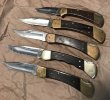David Nowlin
Gold Member
- Joined
- Jan 17, 2018
- Messages
- 2,829
The BladeForums.com 2024 Traditional Knife is available! Price is $250 ea (shipped within CONUS).
Order here: https://www.bladeforums.com/help/2024-traditional/
DeletedSeems its a 1974 5V4V with a 5V6V blade
I made a mistake and thought of 5V3v instead of 5V4v, so what I said wasn't relevant. My apologies.What happened berti?


When you say the hilt I’m assuming you are referring to the tang area that is just back of the cutting edge. That’s the kick, it is for resting on the back spring when the blade is closed to prevent blade rap.Yes the two on the left have different hilt shapes and that was what was throwing me off. What reasons for all the differences? Was it due to the handmade process and different blade makers at Buck had their own shape they preferred?
Again thanks for the V5V4 verification.
Also is mine Ebony wood as mine doesn’t have any of that nice wavy grain look of the ebony handles shown?This knife saw the elements of the Alaskan Pipeline construction project but almost looks like it never cut much of anything.
There is no real definite written history on these knives. Joe Houser spreadsheet is what I use to date and catalog my knives. Bert Lindsey and George Stinzel pointed out small differences in the V5V4 and the V5V7 (two far right knives). They were small changes during the year. The 2 dots are one of my favorite vintage Buck 110s.Yes the two on the left have different hilt shapes and that was what was throwing me off. What reasons for all the differences? Was it due to the handmade process and different blade makers at Buck had their own shape they preferred?
Again thanks for the V5V4 verification.
Also is mine Ebony wood as mine doesn’t have any of that nice wavy grain look of the ebony handles shown?This knife saw the elements of the Alaskan Pipeline construction project but almost looks like it never cut much of anything.
David, try some Lemon Pledge furniture polish. It will gently clean and give some shine but it won’t remove the scratches or character.Is there any way to bring back some shine to the scales without of course ruining the originality?
Ok went back and reread this. Kick is not referring to the clip point portion of the blade my bad.When you say the hilt I’m assuming you are referring to the tang area that is just back of the cutting edge. That’s the kick, it is for resting on the back spring when the blade is closed to prevent blade rap.
There were many changes that didn’t always have explanation to the general public but the cutlers making them knew at that time.
